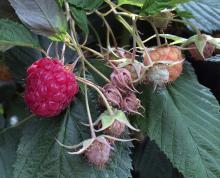See:
Blackberry (Rubus spp.) - Dry Cell (Dry Berry) Syndrome
Cause Described as a fruit blight of loganberry and thimbleberry in British Columbia, Canada in the 1950s caused by the fungus Rhizoctonia rubi. This disease was observed on red raspberry and blackberry in northern Washington and the pathogen was reclassified as Monilinia rubi based on molecular evidence. Growth of the fungus is best between 68 and 77oF. Flowers are the main infection site, but little is known about the life cycle of this fungus.
Symptoms Sepals of green berries are brown instead of green and often do not open out. Druplets are also brown with the necrosis extending down from the receptacle into the pedicel (flower/fruit stem). Berries rapidly mummify becoming gray, leathery, and necrotic. Dry mummified fruit remain on the plant until physically dislodged.
Control Unknown. Both cultural and chemical control programs for other diseases may need to be extended when wet weather continues into late spring and summer.
References McKeen, W. E. 1959. Rhizoctonia rubi sp. nov. associated with the dry-berry disease of the loganberry. Can. J. Plant Sci. 1: 82-85.
Weldon, W.A., McGhee, G.C., Jones, L.A. and Stockwell, V.O. 2022. Taxonomic Reclassification of the Fungal Pathogen Causing Dry Berry Disease of Caneberries into the Division Ascomycota as Monilinia rubi. Plant Disease, 106:2788-2796.




